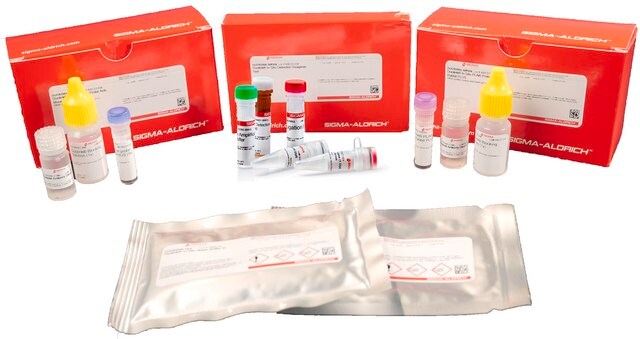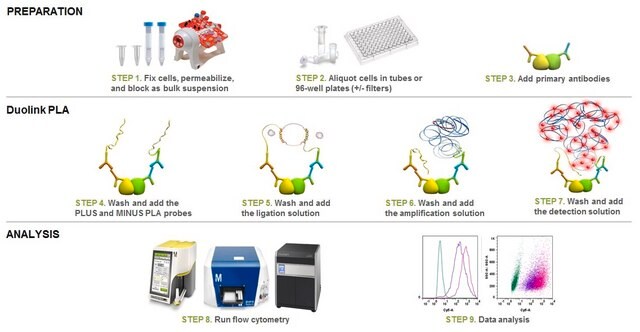DUO94105
Duolink® flowPLA Mouse/Rabbit Starter Kit - Violet
Duolink® PLA kit for Flow Cytometry with Violet Detection and Mouse/Rabbit probes
Sinónimos:
Duolink Starter Kit
About This Item
Productos recomendados
Nivel de calidad
técnicas
flow cytometry: suitable
immunofluorescence: suitable
proximity ligation assay: suitable
fluorescencia
λex 390 nm; λem 476 nm
idoneidad
suitable for fluorescence
temp. de almacenamiento
−20°C
Especificidad
Use appropriate laser for λex 390 nm excitation
Use appropriate filter for λem 476 nm emission.
Application Note
Primary antibodies are needed. Test your primary antibodies (IgG-class, mono- or polyclonal) in a standard immunofluorescence (IF), immunohistochemistry (IHC), or immunocytochemistry (ICC) assay to determine the optimal fixation, blocking, and titer conditions. Flow validated antibodies are recommended.
Let us do the work for you, learn more about our Custom Service Program to accelerate your Duolink® projects.
View full Duolink® product list
Aplicación
Duolink® flowPLA Starter Kits will enable sensitive detection of proteins, protein-protein interactions, and protein modifications within cell populations by flow cytometry. To perform a Duolink® flowPLA experiment, you will need fixed, suspended cells, two primary antibodies that specifically recognize your proteins of interest and the Duolink® flowPLA starter Kit. The flowPLA Starter Kits are available with 3 different fluorophores: Violet, Green, and FarRed. The flowPLA starter Kits contain all the necessary reagents reagents for 100 Duolink® PLA reactions, including a pair of PLA probes (Anti-Rabbit PLUS and Anti-Mouse MINUS) and all the reagents to perform the amplification and detection of bound PLA probes by flow cytometry. Analysis is carried out using standard flow cytometry assay equipment. User must provide a fixed cell suspension, (rabbit and mouse-raised) primary antibodies, and corresponding PLA Probes.
Follow the Duolink® PLA Flow Cytometry Protocol to use this product.
Visit our Duolink® PLA Flow Cytometry page on how to run a Duolink® flow experiment, applications, troubleshooting, and more.
Características y beneficios
- Analyze protein protein interactions with flow cytometry readout
- Analyze cell populations with Proximity Ligation Assay
- Increased sensitivity due to rolling circle amplification for low abundant targets
- No overexpression or genetic manipulation required
- Relative quantification possible
- Works with any flow cytometer instrumentation
- Easy to follow flexible protocol
- Publication-ready results
Componentes
Duolink® In Situ PLA® Probe Anti-Mouse MINUS DUO92004-40TST
Duolink® In Situ PLA® Probe Anti-Rabbit PLUS DUO92002-40TST
Duolink® In Situ Wash Buffer, Brightfield (DUO82047-4L)
See datasheet for more information.
Información legal
PLA is a registered trademark of Sigma-Aldrich Co. LLC
Palabra de señalización
Danger
Frases de peligro
Consejos de prudencia
Clasificaciones de peligro
Aquatic Chronic 2 - Resp. Sens. 1 - Skin Sens. 1
Código de clase de almacenamiento
10 - Combustible liquids
Elija entre una de las versiones más recientes:
Certificados de análisis (COA)
It looks like we've run into a problem, but you can still download Certificates of Analysis from our Documentos section.
Si necesita más asistencia, póngase en contacto con Atención al cliente
¿Ya tiene este producto?
Encuentre la documentación para los productos que ha comprado recientemente en la Biblioteca de documentos.
Artículos
Traditional flow cytometry has been limited in the ability to detect protein-protein interactions and low abundant proteins events — until now. We have combined Duolink® Proximity Ligation Assay (PLA) with flow cytometry in a convenient kit, making the analysis of protein-protein interactions with flow cytometry readouts a reality.
General tips and tricks for proper experiment execution, aid in identifying potential problems, and provide solutions to ensure a successful Duolink® PLA experiment for flow cytometry.
Protocolos
Protocol for use of Duolink® PLA reagents for the detection of individual proteins, protein modifications, and protein-protein interactions within cell populations by flow cytometry.
Nuestro equipo de científicos tiene experiencia en todas las áreas de investigación: Ciencias de la vida, Ciencia de los materiales, Síntesis química, Cromatografía, Analítica y muchas otras.
Póngase en contacto con el Servicio técnico







